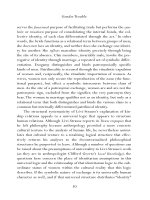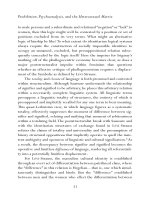GENDER TROUBLE 133
Bạn đang xem bản rút gọn của tài liệu. Xem và tải ngay bản đầy đủ của tài liệu tại đây (20.25 KB, 1 trang )
Gender Trouble
in the ways intended. The example of the negative Oedipal complex
is but one occasion in which the prohibition against incest is clearly
stronger with respect to the opposite-sexed parent than the same-sexed
parent, and the parent prohibited becomes the figure of identification.
But how would this example be redescribed within the conception of
the incest taboo as both juridical and generative? The desire for the parent who, tabooed, becomes the figure of identification is both produced
and denied by the same mechanism of power. But for what end? If the
incest taboo regulates the production of discrete gender identities, and
if that production requires the prohibition and sanction of heterosexuality, then homosexuality emerges as a desire which must be produced
in order to remain repressed. In other words, for heterosexuality to
remain intact as a distinct social form, it requires an intelligible conception of homosexuality and also requires the prohibition of that conception in rendering it culturally unintelligible. Within psychoanalysis,
bisexuality and homosexuality are taken to be primary libidinal dispositions, and heterosexuality is the laborious construction based upon
their gradual repression.While this doctrine seems to have a subversive
possibility to it, the discursive construction of both bisexuality and
homosexuality within the psychoanalytic literature effectively refutes
the claim to its precultural status. The discussion of the language of
bisexual dispositions above is a case in point.48
The bisexuality that is said to be “outside” the Symbolic and that serves
as the locus of subversion is, in fact, a construction within the terms of
that constitutive discourse, the construction of an “outside” that is nevertheless fully “inside,” not a possibility beyond culture, but a concrete
cultural possibility that is refused and redescribed as impossible.What
remains “unthinkable” and “unsayable” within the terms of an existing
cultural form is not necessarily what is excluded from the matrix of
intelligibility within that form; on the contrary, it is the marginalized,
not the excluded, the cultural possibility that calls for dread or, mini-
98









